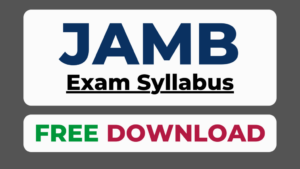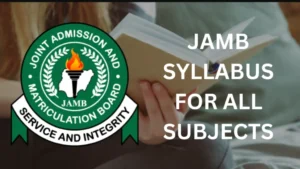The JAMB Syllabus for Mathematics PDF Download is designed to test candidates’ understanding of key mathematical concepts and their ability to apply these principles in solving real-world problems. This syllabus outlines the topics and areas you need to focus on to prepare for the Joint Admissions and Matriculation Board (JAMB) Unified Tertiary Matriculation Examination (UTME).

JAMB Syllabus for Mathematics PDF Download
Here’s a breakdown of the topics and subtopics covered in the JAMB Mathematics syllabus.
Main Topics in the JAMB Mathematics Syllabus
1. Number and Numeration
This section focuses on the basic principles of numbers and their operations.
- Number Bases: Conversion from one base to another (especially between base 2, base 8, base 10, and base 16).
- Fractions, Decimals, and Percentages: Conversion between fractions, decimals, and percentages, and solving related problems.
- Indices: Laws of indices and their applications.
- Logarithms: Use of logarithms to solve problems (logarithms to base 10).
- Sets: Set notation, union, intersection, complement, and Venn diagrams (up to three sets).
- Surds: Simplification of surds and rationalization of denominators.
2. Algebra
Algebra is one of the core areas in Mathematics, and this section covers various subtopics under algebraic expressions, equations, and functions.
- Polynomials: Addition, subtraction, multiplication, division, and factorization of polynomials.
- Quadratic Equations: Solutions of quadratic equations by factorization, completing the square, and the quadratic formula.
- Simultaneous Equations: Solving simultaneous linear equations and simultaneous linear and quadratic equations.
- Inequalities: Solving linear and quadratic inequalities in one variable and interpreting the solution on a number line.
- Algebraic Fractions: Simplifying and solving equations involving algebraic fractions.
- Sequence and Series: Arithmetic and geometric progressions.
- Binomial Theorem: Expansion and application of the binomial theorem.
3. Geometry
Geometry is an essential topic in JAMB Mathematics, covering both plane and solid geometry.
- Angles and Triangles: Types of angles (acute, obtuse, right, etc.), properties of triangles, congruence, and similarity.
- Circles: Properties of circles, including chords, tangents, and cyclic quadrilaterals.
- Polygons: Properties of regular and irregular polygons, interior and exterior angles.
- Mensuration: Perimeter, area, and volume of various geometric shapes such as triangles, rectangles, circles, cones, cylinders, and spheres.
- Loci: Simple cases of loci (perpendicular bisectors, equidistant points, etc.).
4. Trigonometry
Trigonometry involves studying the relationships between the angles and sides of triangles.
- Basic Trigonometric Ratios: Sine, cosine, tangent and their applications.
- Trigonometric Identities: Proving and applying identities such as sin²θ + cos²θ = 1.
- Trigonometric Equations: Solving simple trigonometric equations.
- Angles of Elevation and Depression: Solving problems involving angles of elevation and depression.
- Sine and Cosine Rules: Application of sine and cosine rules in solving triangles.
5. Calculus
Calculus is a higher-level topic but essential for various calculations involving changes and rates.
- Differentiation: Basic differentiation rules, including product, quotient, and chain rules. Applications of differentiation (e.g., finding gradients, rates of change, and maxima/minima).
- Integration: Basic integration techniques and application to areas under curves.
6. Statistics
Statistics is a major section in the JAMB Mathematics syllabus, focusing on data collection, analysis, and presentation.
- Measures of Central Tendency: Mean, median, and mode for both grouped and ungrouped data.
- Measures of Dispersion: Range, variance, and standard deviation.
- Probability: Basic concepts of probability, including the probability of simple and compound events.
- Permutations and Combinations: Basic principles of permutations and combinations.
- Cumulative Frequency: Construction and interpretation of cumulative frequency tables and curves (Ogive).
7. Vectors and Matrices
- Vectors: Addition, subtraction, and scalar multiplication of vectors. Representation of vectors in two dimensions, and application of vectors to solving geometric problems.
- Matrices: Addition, subtraction, multiplication of matrices, determinant of a 2×2 matrix, and finding the inverse of a 2×2 matrix. Application of matrices to solve simultaneous linear equations.
Key Points to Focus on for JAMB Mathematics
Practice past questions: Go through JAMB past questions to understand the format and types of questions asked in the exam.
Time management: Work on solving problems efficiently within a limited time since the JAMB Mathematics exam consists of multiple-choice questions.
Understand formulas: Memorize key formulas for geometry, trigonometry, algebra, and calculus, and practice applying them to solve problems.
Calculator use: Get familiar with using a scientific calculator, but be mindful that calculators are not allowed during the exam. Ensure you practice mental calculations and solving problems by hand.
Recommended Textbooks for JAMB Mathematics
To prepare adequately for the JAMB Mathematics exam, consider using the following textbooks:
- “New General Mathematics for Senior Secondary Schools” (Books 1-3) by M.F. Macrae et al.
- “Mathematics for Senior Secondary Schools” by P.N. Odili.
- “Further Mathematics Project” by M. Adu and J. Egbe.
Jamb Syllabus FAQS
Is the JAMB syllabus different for UTME and Direct Entry?
The JAMB syllabus is primarily designed for UTME candidates. Direct Entry candidates may not need the syllabus as their admission process is based on their A-level or equivalent qualifications. However, some Direct Entry candidates may still find the syllabus useful if they are required to take certain exams.
How do I know if I’m using the correct JAMB syllabus?
Always download the syllabus from the official JAMB website or trusted educational platforms. Ensure the syllabus is for the correct exam year.
Can I combine the JAMB syllabus with past questions?
Yes, combining the JAMB syllabus with past questions is an excellent strategy. It helps you understand the exam pattern and practice questions based on the syllabus topics.
Can I pass JAMB without using the syllabus?
While it is possible to pass JAMB without the syllabus, using it significantly increases your chances of success. The syllabus ensures you cover all the necessary topics and avoid wasting time on irrelevant material.
Are there recommended textbooks in the JAMB syllabus?
Yes, the JAMB syllabus includes a list of recommended textbooks for each subject. These textbooks are aligned with the syllabus and are useful for in-depth preparation.
How can I use the JAMB syllabus effectively?
- Download the syllabus for your chosen subjects.
- Study the recommended textbooks and materials listed in the syllabus.
- Focus on the objectives and topics outlined for each subject.
- Practice past questions related to the syllabus topics
Does JAMB set questions outside the syllabus?
JAMB has stated that all UTME questions are based on the topics outlined in the syllabus. However, some questions may test candidates' critical thinking and application of knowledge.
How many subjects are in the JAMB syllabus?
The JAMB syllabus covers all the subjects offered in the UTME, including:
- Use of English (compulsory for all candidates).
- Science subjects (e.g., Physics, Chemistry, Biology, Mathematics).
- Arts and Social Science subjects (e.g., Literature, Government, Economics, Commerce).
- Other subjects like Agricultural Science, Geography, and Religious Studies.
Is the JAMB syllabus the same every year?
The JAMB syllabus is periodically reviewed and updated. However, changes are usually minimal. Candidates are advised to always check for the latest version of the syllabus for their exam year.
Where can I download the JAMB syllabus?
The JAMB syllabus is available for free on (jamb-portal). You can also find it on other educational websites or platforms that provide JAMB resources.
Why is the JAMB syllabus important?
- It helps candidates focus on relevant topics.
- It ensures candidates are well-prepared for the exam.
- It reduces the chances of studying irrelevant material.
What is the JAMB syllabus?
The JAMB syllabus is an official document that outlines the topics and subtopics candidates are expected to study for each subject in the Unified Tertiary Matriculation Examination (UTME). It serves as a guide to help candidates prepare effectively for the exam.
Conclusion
The JAMB Mathematics syllabus covers a wide range of topics, from basic arithmetic to more advanced topics like calculus and statistics. To succeed, candidates must focus on practicing regularly, understanding key mathematical principles, and applying them to solve problems. With consistent practice and familiarity with the syllabus topics, candidates can excel in the Mathematics section of the UTME
